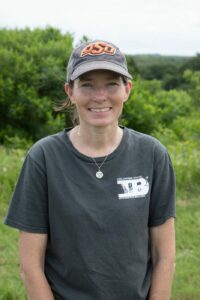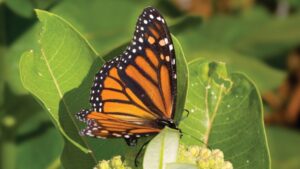Road trip shines a light on projects along the Monarch Highway.
Monarch butterflies travel around 3,000 miles each year on their annual migration. This summer, a team from Syngenta took a trip of their own in honor of National Pollinator Week, and though there are important pollinator habitat projects going on across the country, the road trip followed the Monarch Highway.
The I-35 corridor has been dubbed the Monarch Highway because it parallels the central flyway of the monarch migration across the United States throughout the spring, summer and fall months. Monarchs sometimes travel between 50-100 miles a day, so it can take up to two months to complete their journey from Mexico to Canada.
From June 18-22, the Syngenta team drove through five states in five days, with 14 stops in 12 cities throughout Texas, Oklahoma, Kansas, Iowa and Minnesota.

Ann Bryan, Syngenta senior manager of external communications, says the goal of the trip was to bring the stories from a variety of pollinator habitat projects to life for those who otherwise wouldn’t know about them.
“We learned so much from all the experts we were able to visit with,” Bryan says. “But the ultimate goal was to shine a spotlight on the positive efforts others, as well as Syngenta, are doing to improve pollinator health and preserve and enhance natural habitats.”
Stops were chosen to represent a diverse cross-section of researchers, conservationists and landowners who are helping protect pollinators and improve their health. Sites varied from roadside maintenance programs and university research to golf courses, private farms, and even an Air Force base.
Bryan says the team did a lot of research prior to the trip.
“We knew we wanted to follow I-35, so we looked for sites with pollinator activities along that route and reached out to as many as we could,” Bryan says.
Pollinator Progress
While many of the projects along the road trip route focus on Monarch butterflies, they benefit many other pollinators as well.
For example, the group stopped at Oklahoma State University to meet with Kristen Baum and her team, who manage a few different projects to promote the growth of milkweed in Oklahoma. Milkweed is the essential plant Monarchs need to survive, but it also provides nectar for other pollinators. Even deer and rabbits have been known to munch on the leaves of this important plant.
The Syngenta road trip team met with Baum’s team on the side of the highway to learn about their efforts to reduce mowing and identify the timing of mowing that helps the plant thrive during important times of the year.
They also traveled to a rangeland site to learn about the patchwork burning techniques being utilized there.

“We have a lot of good opportunities in Oklahoma to study and improve existing habitats,” Baum says. “One of our main goals is to simply adjust existing mowing regimes to better support milkweed growth, while still addressing other roadside management needs, such as controlling invasive species.”
In the grassland areas, prescribed burnings limits brush encroachment to allow existing native vegetation to thrive. Both of these methods allow for increased pollinator habitat without needing to plant any new seeds or devote land to a new habitat.
“It’s an interesting puzzle, and there isn’t one answer for all locations,” she says. “It’s about finding what works best depending on what that exact location needs.”
Geographical Differences
Bryan and her team found that the southern states focused much more heavily on managing existing habitats, such as roadsides or grasslands. Projects on the northern end of I-35 tended to revolve more around creating specific pollinator plots.
Baum says those differences are in part because of the many different species of milkweed that grow along the Monarch Highway.
“In the southern regions, our native milkweed species tend to be smaller and grow as individual plants, whereas common milkweed, more commonly found in the northern regions, can be taller than a person and spreads below ground to form relatively dense stands, so there are different challenges when incorporating these species into habitats,” Baum says.
Another consideration is that Monarchs need milkweed to be evenly distributed to reach their full reproductive potential. It can take up to five generations of Monarchs to complete the journey from Canada to Mexico, and back again. And if there is insufficient milkweed at any point in the journey, the migration could potentially fail.
“It’s important to consider that distribution when we’re thinking about managing existing habitat or planting new habitat plots, no matter where you are along the route,” Baum adds.
Milkweed and other native wildflowers are essential for native bees and other pollinators as well, even honeybees, so all of these efforts fit together to form an impressive drive toward better pollinator stewardship.
“One of the most exciting parts of the trip was seeing the creativity and passion that goes into these various projects,” Bryan says. “There are so many things we don’t think about on a daily basis but when you hear a success story like one of these, it helps us realize that no matter where you are or what you’re doing, everyone can create a pollinator habitat.”
A Continuing Journey
In the end, the team covered more than 1,700 miles in their van, a little over half of the Monarch’s journey between Canada to Mexico. But Bryan said she hopes the stories they collected will continue to travel the world through social media as they spread awareness and appreciation for pollinator habitat projects.
Syngenta was able to share 61 social media posts with details from the road trip and received more than 8,000 engagements and nearly 6,700 video views just a month after returning home.
Those numbers continue to rise. The stories were also shared internally with Syngenta employees, which helped bring home the company’s commitment to biodiversity.
“Sharing the photos and videos from our trip in real time with all of our employees lets them feel as though they were there with us, and it helps them see firsthand what is going on so they are a part of it,” Bryan says.
The pollinator health projects are also an ongoing journey, and one that’s difficult to measure.
“From the Monarch perspective, we are seeing a positive response,” Baum says. “We’re tracking milkweed density and seeing good Monarch usage, but it’s hard to compare year to year. However, it’s pretty clear that managing habitats has a positive effect.”
Bryan is also excited about the connections this trip created.
“We were able to build some tremendous relationships with the amazing experts we met,” she adds. “And we hope to be able to return to those connections as we work on future projects in the coming years. It gives us a great opportunity for learning from each other and perhaps collaborating.”
And unlike the Monarchs, which make their journey every year, Bryan doesn’t necessarily think they’ll plan a road trip next year for National Pollinator Week.
“It was a very special trip, really invaluable,” she notes. “Pollinators are essential to agriculture, so we’re always looking for a fresh idea to celebrate this important week every year.”











